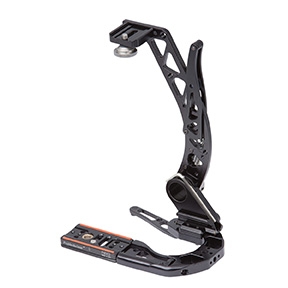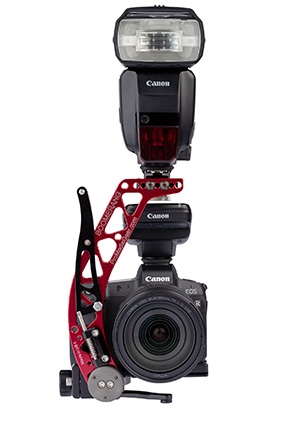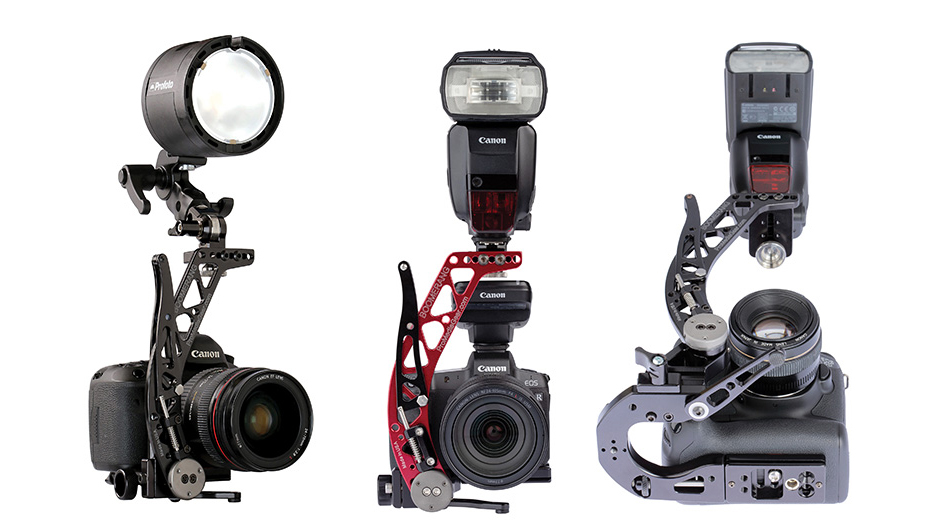Design Value: ProMediaGear BBX Boomerang Flash Bracket
The ProMediaGear BBX Boomerang has changed Ellis Vener's feelings about flash brackets.
• December 2018 issue
I’ve had an ongoing tolerate-hate relationship with flash brackets for decades. Each one I’ve owned has been an awkward one-trick pony. But the ProMediaGear BBX Boomerang has changed my feelings about flash brackets. Designed by working photographers, the Boomerang has gone through a series of refinements since it was introduced in 2010 by ProMediaGear’s engineer-photographer Fudala brothers. The bracket’s name is derived from the boomerang-like curve of the arm, an asymmetric arc that keeps the light centered over the lens.
This is a pivoting bracket that comes in right- and left-handed (BBX and BBXL) versions in both a standard size and a tall configuration that’s suited to large-bodied cameras as well as standard bodies with a vertical grip battery pack. The Boomerang locks into the ends of ProMediaGear’s Arca-Swiss type quick-release plate, which is the hub for a system of components.

The heart of the Boomerang is the pivoting arm. The arm itself is an arcing piece of anodized (black, red, yellow, or blue) aircraft-grade aluminum that can pivot between upright and lateral angles. The pivoting mechanism controls the position of the flash with a spring-loaded piston and a notched disk that locks the piston in one of two positions. A light squeeze of a palm-sized lever on the arm retracts the piston to quickly pivot to the other orientation. For flash work, I’ve used it with full-size speedlights as well as the Adorama Flashpoint eVolv 200 TTL Pocket Flash (Godox AD200) and the Flashpoint XP-200 V2 portable extension cable.
Because it swiftly attaches to—rather than replaces—the quick-release camera-to-tripod mount, the Boomerang can easily switch from landscape to portrait orientation while handheld or on a tripod. It can also be used with small soft boxes or collapsible beauty dishes (up to about 22 inches in diameter). It’s workable, but keep in mind that a larger light source and soft box means you’re carrying more weight and an unwieldy rig.
More complex lighting options are possible. Attach a right- and left-handed Boomerang to the QR plate to create a great, if heavy, portable clamshell portrait light setup. On a more reasonable scale for video work you can mount a small LED array and soft box or position a shotgun microphone near, but not next to, the camera. You can also add a short arm and a geared pivot to the flash mounting platform to tilt the light down over a subject for macro photography.

Two qualities that stand out are the comfort of photographing with a Boomerang and the quality of light I can get from it. By positioning the light farther from the lens than most other flash brackets are capable of, I can achieve more interesting and flattering light without the rig being cumbersome. I also like that it’s a modular design that works easily with my camera’s quick-release foot.
ProMediaGear’s modular approach and mounting accessories make it a versatile system instead of just a flash holder. Operation is straightforward, and for storage and transportation, the lower part folds against the arm for a compact configuration. When you’re ready to take a break and want to put the camera and flash down, a leg swings out from the base to keep the rig upright and balanced.
The Boomerang is strong enough to support lights as heavy as a Profoto B2 with soft box, or if you want to give yourself a real workout, the new B10 monolight.
At $299.95, it’s more expensive than the average flash bracket, but the versatile design of the ProMediaGear BBX Boomerang makes it a better long-term value.


